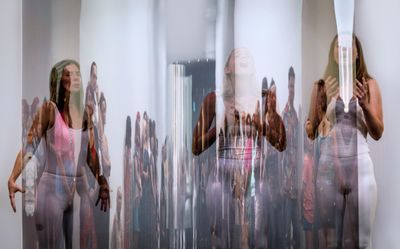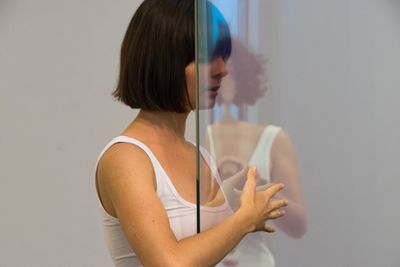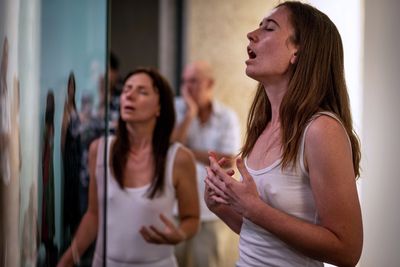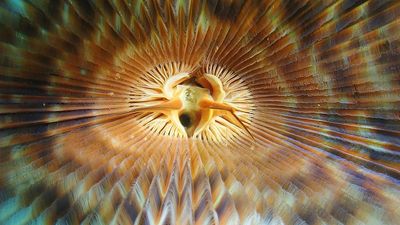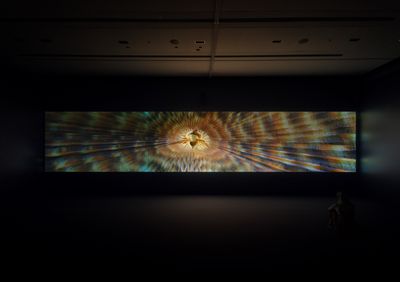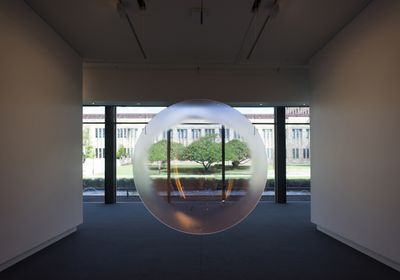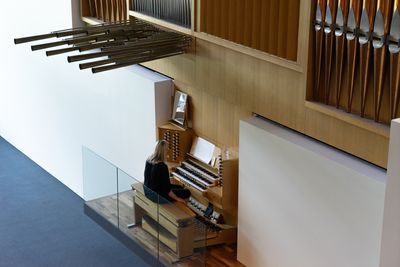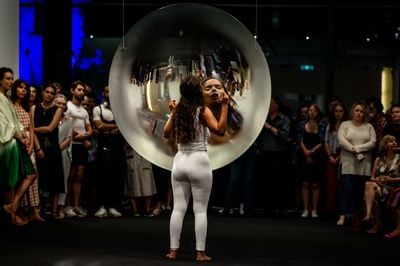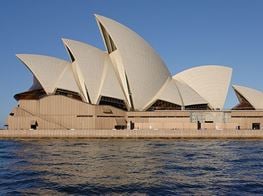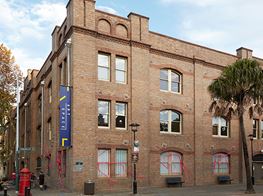Mel O’Callaghan and Dr. Daniel J. Fornari: In Search of Life
Curator Peta Rake, artist Mel O'Callaghan, and Dr. Daniel J. Fornari Emeritus Research Scholar, Woods Hole Oceanographic Institution. Centre of the Centre publication launch, 2020. Courtesy UQ Art Museum, Brisbane. Photo: Simon Woods.

Curator Peta Rake, artist Mel O'Callaghan, and Dr. Daniel J. Fornari Emeritus Research Scholar, Woods Hole Oceanographic Institution. Centre of the Centre publication launch, 2020. Courtesy UQ Art Museum, Brisbane. Photo: Simon Woods.
Working across film, video, performance, painting, and installation, Sydney-born, Paris-based artist Mel O'Callaghan explores the human condition through processes of resistance and endurance.
In her video installation Ensemble (2013), most recently shown across a 20-metre-wide space at the National Gallery of Victoria (17 November 2017–12 March 2018), a man stands alone in a field with his back in the firing line of a high-intensity water canon directed by three firefighters. His body withstands the pressure as he proceeds towards them.
Human endurance was taken further in Dangerous on-the-way at the Palais de Tokyo (3 February–8 May 2017), for which O'Callaghan travelled to the dark summit of Simud Putih, or 'white cave', in Gomantong of northeast Borneo. There, the artist followed the indigenous Orang Sungai people on their twice-yearly ritual to harvest birds' nests from heights of 120 metres.
Witnessing these highly choreographed acts and their ritual importance, O'Callaghan developed, among other works, the performance piece To Hear With My Eyes (2017). Relating to the physical and mental state of 'ekstasis', described in Greek as 'being outside oneself', performers engaged with various sculptural tools symbolising stages of reaching an ecstatic trance, informed by a method developed in the 1970s by anthropologist and linguist Dr. Felicitas D. Goodman, founder of the Cuyamungue Institute.
O'Callaghan's most recent exhibition, Centre of the Centre, presents sculptures, a film, and a series of performances linked by the circulatory motion of breath, including Respire, Respire (2019), which features performers breathing in chorus at intervals to achieve an altered state of consciousness. The exhibition will be presented across 13 institutions between 2019 and 2023, starting with co-commissioners Le Confort Moderne, Poitiers (14 June–18 August 2019), Artspace, Sydney (21 August–27 October 2019), and the University of Queensland Art Museum, Brisbane(22 February 2020–16 January 2021).
The exhibition was presented at the Museum of Contemporary Art and Design MCAD in Manila (5 September–1 December 2019), and will tour to nine regional spaces in Australia with Museum & Galleries of New South Wales, ending in 2023 at the Samstag Museum of Art in Adelaide.
Exploring the cycles of regeneration, destruction, and the origins of life, Centre of the Centre was created in collaboration with a team of scientists, led by marine geologist Dr. Daniel J. Fornari of the Woods Hole Oceanographic Institution. The artist and her assistant, Alexandra Pedley, were participants on a research cruise studying hydrothermal vents at a volcanic mid-ocean ridge in the eastern Pacific Ocean, using the research vessel Atlantis and deep-diving submersible named Alvin. The exhibition's titular film captures these vents as breathing life into the ocean, laying bare complex systems that exist in extreme environments—sites that O'Callaghan sees as representative of the genesis of life. Additional footage of shallow water sites used in the film were collected during diving in the Verde Island Passage in the Philippines.
In this conversation, which took place at Centre of the Centre's opening at UQ Art Museum in Brisbane, O'Callaghan and Fornari speak with the museum's senior curator Peta Rake about the synergies between science and art that gave way to this body of work.
I'd like to begin by talking about breath, and how it connects all of the artworks in Centre of the Centre, including the performance Respire, Respire (2019), which features 11 performers breathing in chorus with one another at intervals, in order to achieve an altered state of consciousness.
MOCFor this performance, I collaborated with Sabine Rittner, a researcher with the Institute of Medical Psychology at Heidelberg University, Germany. Our relationship began when I had an exhibition at the Palais de Tokyo and presented a trance induction performance piece, To Hear With My Eyes (2017). In that performance, I saw the potential of breath and how it was profoundly affecting the performers. Sabine wrote an essay for the exhibition publication, and at the conclusion of the exhibition I asked if we could collaborate on a future work. I asked her, 'How can we push the performers to the very edge of consciousness?' In 2018, I went to Heidelberg to work with Sabine and her colleagues to research and test methods we could develop into a new performance work.
The glass sculptures comprise one of three parts of Centre of the Centre, which is made up of installation, video, and performance. Each component speaks to the other, connected through sound and breath. The performance is a trance induction that is guided by a composition of repetitive beats and melodic interludes. I applied this same approach to the edit of the film with the intent that it could also induce an altered state of consciousness. The structure of the film is exactly the same as the performance, and I love that quality to it.
The film looks at how hydrothermal vents are breathing life into the sea. I learned that there were organisms called 'extremophiles' that live on these vents, on the boundary under which life can thrive, and I just thought that was perfect. Living in a myriad of extreme conditions myself, I too feel like a type of extremophile, and so that's something that really developed where I wanted to go with the performance.
I reached out to a deep-sea microbiologist called Dr. Anna-Louise Reysenbach, from Portland State University, and she really helped to provide direction and background research at the very beginning. Every conversation I had with her just became very inspiring. When I was unable to join her on the expedition we had planned to Brothers Volcano in the Pacific Ocean, Anna-Louise kindly introduced me to Dan.
Can you describe what the experience was like to have an artist on the research ship Atlantis?
DFThis was a new experience for me, to have a world-renowned artist interpret some of the work we do as scientists, which I think is pretty cool. I'm very grateful for the museum and the museum staff—museums are the crucibles of knowledge, inspiration, and interpretation, and we don't have that equivalent in science. We have the papers that we write, and we have audiences, our peers, and students, but it's quite different, so this ability to interpret science is something that I think is really important. That was the motivating quality for me and my colleagues.
Once they all met Mel on the ship, it worked really well because of Mel's dedication, personality, and perseverance, and all the qualities that she and her assistant, Alexandra Pedley, brought to the project.
I learned that there were organisms called 'extremophiles' that live on these vents, on the boundary under which life can thrive, and I just thought that was perfect.
Can both of you visually and geographically locate us in the film? What might we encounter in the hydrothermal vents, which mark the beginning of the film, and the photomicrographs that mark the interstitial moments, and so on?
DFThe film takes place at a site in the eastern Pacific Ocean, at an approximate depth of 2,500 metres. At the start of Mel's film, you see a bit of volcanic seafloor. The bottom of the ocean is where the crust of the earth is formed, which is pretty fundamental, yet many people don't realise it.
We studied the volcanic systems and the volcanic processes at the bottom of the ocean to learn about how the earth and the oceans interact; we have been going to that particular site for a number of decades. I've actually been studying the eastern Pacific and this particular ridge where the ocean crust is generated for about the last 35 years of my career. So, we were looking at that site, and also a site nearby, within about 100 miles, which is where there is a very intense hydrothermal vent system that has been operating since we discovered it in the late 1980s.
The film takes advantage of the research that has been done in these two areas, all funded by the U.S. National Science Foundation and involving many different investigators, biologists, chemists, geologists, and engineers who are looking to understand how the ocean crust is formed, and what the chemistry is of the melt that is generated in the mantle that comes up to the seafloor.
We are trying to understand the source of volcanism, and its impacts on biological communities—especially those that are relying on all of those chemically laced or infused fluids that are coming out of the bottom of the ocean floor. Those biological communities exist because of the chemosynthetic capacity that they have, which is very different to plants, which are all reliant on photosynthesis. Up until about 45 years ago, we thought that there was only photosynthesis. It turns out we were wrong—chemosynthesis is a process that is very fundamental, and it's probably been around since the beginning of time. I think that was one of the attractions for Mel: that the site has the potential to be the centre of the creation of life, and a sort of crucible for where life can form.
MOCWith one of the scientists, Ross Parnell-Turner, Assistant Professor in the Cecil H. and Ida M. Green Institute of Geophysics and Planetary Physics at Scripps Institution of Oceanography, we worked out a method using the submarine Alvin to get the images we needed. Suddenly, the submarine became more than just a vehicle to get to the bottom of the sea—it also became a tool, like a camera on a dolly, because we used the submarine to get movement that was much smoother.
We were really looking for situations where we could minimise the impact of the film upon the science being undertaken. One part of that was a series of interviews myself and my colleague Alexandra Pedley conducted on the ship. In those interviews, we asked the scientists what they are passionate about, to find out what they really love. The scientists were very creative about what they do and how they approach their work. Dr. Santiago Herrera, a Lehigh University professor in the Department of Biological Sciences researches deep-sea worms, and Dr. Karthik Anantharaman, Assistant Professor in the Department of Bacteriology, University of Wisconsin–Madison, was very passionate about the gas plumes coming out of the vents, for example. As soon as I knew their passions, I was able to collaborate with them to get some rare imagery.
The camera technology we used is something that Dan has pushed and developed. Not only is he a scientist who's doing such incredible work and got me out there, he's also been driving the technology of underwater photography, so I can't overstate how important this collaboration was. I went on the ship thinking that the 'origin of life' was in the vents, but in my interview with geologist Dr. Michael Perfit, a Distinguished Professor at the University of Florida, I really understood that this new life begins in the rocks. From this conversation, I felt it was really necessary to start the film in the seamount chain, at that point where life truly begins, rather than just going straight to the hydrothermal vents and capturing everything there.
I think that was one of the attractions for Mel: that the site has the potential to be the centre of the creation of life, and a sort of crucible for where life can form.
Both you and Mel have mentioned the word 'extremophile', which translates from Latin, 'extremus', and Greek, 'philiā', to 'extreme love'. Extremophiles are organisms whose environmental conditions are considered extreme and challenging to survive in.
There are many creatures and forms in Mel's footage, and the one thing that strikes you while you are watching the film is scale. Not all the forms are microbial—sometimes they're larger and at a human scale. So there is a kind of beauty in the way in which we can watch those images, because we can imagine that these forms are 'us' in a way—you see something that might look like 'lungs', for example, in a creature that is hundreds of millions of years old.
DFThe scale of the life forms crosses a very large spectrum—from a microbial and frankly even molecular level, depending on what field you're in, to features and elements such as seamounts that can be thousands of metres tall. There are volcanoes at the bottom of the ocean that rival the biggest volcanoes that we have on land.
The way Mel attends to every detail of the project—from the gift her grandfather gave her, to microbial rocks and the day-to-day nuances of the performances—is also spoken about in an essay that is included in the book by Elizabeth A. Povinelli and Kathryn Weir, entitled 'Treating Rocks As If They Matter', and it relates to this moment of thinking about the importance of caring for both human and non-human life.
What should we be attending to as human beings? What should we actually be taking care of, and why should we be thinking about rocks and these microbial organisms as deeply important?
DFAs scientists, we often enter into a situation not necessarily thinking about the 'feelings' of the topics we are interested in, but there is a great deal of beauty that is found in both inanimate and animate forms that you see on the ocean floor. The interesting thing for me as a geologist, and that I have come to appreciate, is that the rocks are there and they form by these very fundamental earth forming processes, but after they form, it's all about chemistry and biology. It's how the seawater impacts the rocks, and over the last decades we've come to find out the ways in which biology mediates, alters, and impacts the rocks and their structure, and how they evolve and age is pretty fundamental.
I was out at sea a little over a month ago doing more work, and one of the groups that was out with me was looking at iron oxides in the rocks, and the weathering of the rocks. A little less glamorous than the hydrothermal vents and the stuff that's coming out at 350-degrees centigrade heat, they are interested in processes that are going on at maybe a few degrees above ambient, or about 2–5 degrees Celsius. It's now recognised that these are pretty important aspects to the geology and the evolution of the biology and processes that are going on in the deep sea.
The three of us have been talking about how important it is to be curious. This is a really successful example of when two equally curious disciplines—science and art—come together. This transdisciplinary approach means there are many layers of translation that happened across both the process of making the work. Could you talk about how you collaborated and found a language to work with one another?
DFTo reinforce what Mel said, this was truly both a labour of love and collaboration—a collaboration on many levels, especially with the group of young scientists that we had on this particular cruise. I'm very grateful for the collaboration with Mel, and so are many of the people that we ended up working with, because we've formed this bond and have new appreciation for the work they were doing, and how they might help with Mel's particular project. Mel taught them a lot as well, about how they could, for example, collect visual data or better document the kind of processes that they are interested in seeing, in a way that makes it more meaningful for them. It was a very symbiotic relationship, just like those found in many biological systems.
MOCThey don't end at the end of the project. I'm still in conversation with a lot of the people involved in the project. Dan and I have started talking about other future work. Those relationships feed into your practice and your life, and I think that's important. Another really beautiful aspect of being on the ship was education. I was being educated, and I hope that I began to educate the scientists. We could be together—a technician, a visionary, and an artist—thinking about imagery and the ways that it can be presented. I think together we were able to get that across. Every dive just came back better and better. It was a really exciting process.
There is a point towards the end of the film where there is a curious phenomenon that happens. The phenomenon is called 'shimmering', and I think it's a really important moment where all of the glass works—which are simultaneously transparent and reflective—and the performance and breath connect. It's about state change; to pass through something and the ability to return.
MOCThere is a beautiful wide frame that is shown across three channels towards the start of the film, where you're seeing vents and Alvinella worms coming in and out of focus. What is out of focus is actually 'shimmering'. It's this state between gaseous and fluid, let's say 350-degrees Celsius and 2-degree water, and in between that you have something else, and it's this shimmering that is no longer water and no longer gas. Is that right? [laughs]
DFMore or less. It's like you're looking at a mirage, except it's under water and you're looking at variations in temperature over an interface, and that's what happens at hydrothermal vents, because you have very hot water that comes out the top and it's like smoke, which is mineral-laden and it's at 350 degrees, and then it comes out into the ambient water, which is near freezing, so the minerals drop out and they form these beautiful chimneys with all the metallic minerals. While those chimneys may look solid, they are really sponges; they are very permeable. There are fluids coming out of them that bathe the sides and the areas that are at a lower temperature, but it's at those lower temperatures where a lot of the biology thrives.
The camera technology we used is something that Dan has pushed and developed. Not only is he a scientist who's doing such incredible work and got me out there, he's also been driving the technology of underwater photography...
They are extremophiles, and some of these animals are called Alvinella worms—they've got little pink heads with tentacles on them, and the back ends of them live inside the chimney. I've often described them to audiences and students as having their heads out in the icebox, cause it's near freezing, and they've got their asses in the oven, because the temperatures within the vent structures themselves are easily over 100 degrees Celsius. In the length of about three to four centimetres—about as long as my finger—they experience a temperature range that is pretty astounding, and it makes you think about your metabolism and whether or not you'd be able to survive in those conditions. It's pretty dubious, but they've figured it out and they like it.
MOCWhen Dan says 'interface', I say 'threshold' and 'transformed state'. I never expected or knew about the Alvinella worm prior to going on the Atlantis with Dan, but I really felt like it said something about the whole project. This little worm and its existing in these multiple states and elements, was a really perfect representation of what I was trying to do with the work.
The other part of the film we haven't touched upon, and its namesake, is the Centre of Marine Biodiversity, Verde Island Passage, in the Philippines. Because it's featured at the end of the film, it represents a rising from the 'depths' of the ocean and entering into the 'shallows', so to speak. I'm wondering whether you could talk about why that site was so important?
MOCIt was the first place I went to. I'd just come out of this big work at Palais de Tokyo, where I'd gone into caves in Borneo to film men who collect birds' nests at a height of about 100 metres. The environment in the caves is just unlivable, but there were these incredible men in there working. Their families having been doing this for over 500 years in this one indigenous group.
At first, I was like, how the hell are they in here? I thought I'd only go in once, but I went in there over two years every day for two months, and the one thing that I really walked away from—apart from the death everywhere—was this sense of new life. It was a real ecosystem, as you were witnessing things eating each other alive. There was this really beautiful and really assuring quality of things growing in this environment that was completely in the dark. It felt right.
A few things were happening in my life, which I wouldn't normally go into, but I was having a child with a surrogate and she was growing in another country. During this whole exhibition period, it just felt like the right moment to think about how life begins. I have a small mineral my grandfather gave me when I went back to Australia around the time of that Borneo exhibition. I held it up to the light and I noticed there was water in it. I asked myself, 'What is in the water? Could it bring new life? Was it dangerous? Was it anything?' That really all started that process of looking at new life, what that meant, and what it was.
I came across an area in the Philippines called the Verde Island Passage, and in particular Verde Island, where they were finding more new life species on each dive. One thing they found was the 'nudibranch'—a small sea slug-like creature with very pretty colours. It's beautiful. The name actually translates to the 'naked gill', and I had been starting to think about breath, and that led me down to the vents, and the idea of breathing life into something. That's the final part of the film, where you see these depths, rocks, and vents, and then further up into the proliferation of life.
In one of those great, passionate conversations I had with Dan's oldest friend and colleague, Dr. Michael Perfit, who we were on the ship with, I asked him about origin of life and the extremophiles, and he pointed that where it really begins is with the rocks.—[O]


